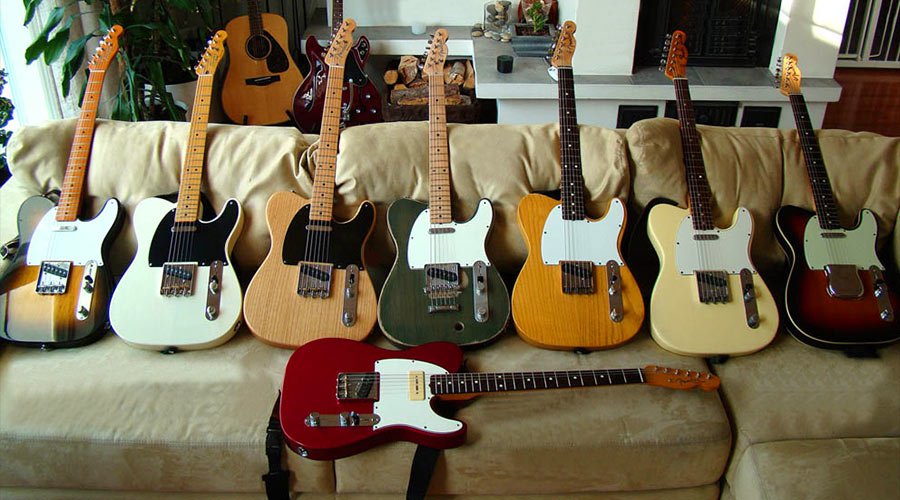
Photo by Freewheeler
So, you are in the market for a new Fender Telecaster but are wondering which one to buy. Do you know which ones are junk and which are the best?
That, my friend, is a loaded question, and we first need to dive deeper into the Wonderland of Telecasterly to find the answer.
The Beginnings
Leo Fender first introduced the Telecaster Spanish Electric Guitar (yep, that was how he described it in their 1950’s price list) as an additional product to his lap steel and amplifier portfolio. Fender had been building amplifiers and lap steel guitars since the 1940’s and many of the design elements of those early lap steels found their way into the design of the now iconic Telecaster.
The knurled control knobs, the ashtray bridge cover, the bridge and bridge pickup configuration, and even the Kluson tuners were all borrowed from the Hawaiian lap steel designs Fender was already producing.
Leo was a shrewd businessman, and even though he didn’t play guitar, he was very familiar with the music scene. His first business venture was building public address systems for dance halls, and those experiences gave him insight to create a legendary musical instrument.
Paddle or Shovel
When Leo unveiled his newest creation, it was subsequently mocked, with some calling it a “boat paddle” or a “snow shovel” because of its shape. Leo had done his homework, however; he created a solid body stringed instrument that would replace the electrified archtop guitars that were prone to feedback and were cost prohibitive for many guitarists. An American icon was soon established which has become a workhorse in the music scene for the last 70 years.
The Telecaster’s unique sound has shaped the musical spectrum of not just county and western, but jazz, blues, rock, punk, pop and any other musical genre where a guitar is required.
Birth of a Legend
Today the early Telecaster models are still considered to be the benchmark for which all Telecasters are measured. The original Blackguards of 1951-1954 are easily recognized by their black bakelite pickguards and butterscotch blond finish. In late 1954, Leo changed the pickguard material to a white single-ply plastic giving birth to the “white guard”, an era which ran for a decade. Guitars manufactured from 1951 to 1964 are very desirable today, some fetching close to a quarter million dollars at auction.
Got a time machine and a couple of C notes?
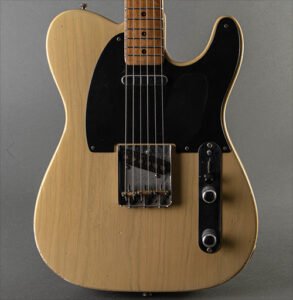
Photo by Carter Vintage
My father-in-law bought a brand new 1956 Telecaster and a 1954 Deluxe amp in January of 1957. He went to the music store with his brother, who also intended to purchase a guitar, although he wanted the new Stratocaster model. To their dismay, the music store was sold out of Stratocasters, so they both walked out with a Telecaster in one hand and a Deluxe amp in the other. And, get this, they each spent a little under $370. Who said guitar collecting was a bad financial investment?
If you have a lot of money sitting around and want a vintage Fender Telecaster, you really can’t go wrong with a 1953-54 Blackguard Telecaster. If Keith Richards and Bruce Springsteen use them, well, enough said.
The CBS Years
In 1965, CBS (Columbia Broadcasting System, you heard that right, the TV station) bought Leo Fender’s company for $13M. The time that CBS held the company before it was sold to Fender Musical Instruments in 1985 is considered to be a down time for Telecasters. Design and material changes, along with cost-cutting in the manufacturing processes, attributed to a lack of quality during this time. Not to say that CBS did everything wrong during this time; they introduced a number of new products, including the semi-hollow Starcaster which boasted humbucking pickups! They also introduced the Telecaster Custom, Deluxe, and Thinline models during this time as well.
However, the traditional Telecaster guitars manufactured during this time are not considered to be the best examples of Leo’s creation. They did, however, happen upon a niche when they made a Telecaster out of Rosewood. Yes, they made a Telecaster with not only a Rosewood fingerboard but a Rosewood neck and body as well. The prototype was given to a young guitarist named George Harrison who played with this little English band called the Beatles.
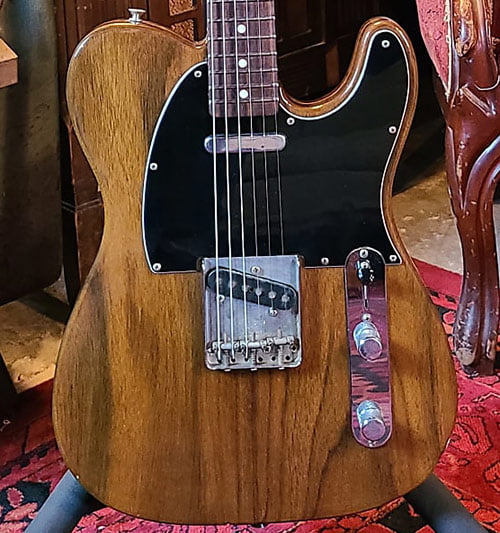
Photo by Six String Brokerage
You can actually see the Rosewood Telecaster on the recent Peter Jackson film, “Get Back” when they played the rooftop gig. Harrison’s Rosewood Telecaster would find itself on tracks like “Get Back,” “Let it Be,” and “Long and Winding Road” to name a few. Harrison’s guitar sold in the early 2000’s for just shy of half a million dollars.
As a disclaimer, a 1968-72 Rosewood Telecaster is really heavy, so you want to play a lot of seated gigs. It also has a distinct sound because of its construction, so it’s not for everybody. But if I were to pick a CBS-era guitar to own, how can I overlook one that shifted the musical landscape in such a dramatic way? A nice example can be had for less than the cost of a used pickup truck today.
It looks like a Telecaster…but different
CBS does get a lot of blame for not producing the best Telecasters during their time of ownership, but that doesn’t mean they did not do anything right. The Custom, Deluxe and Thinline Telecaster models all came from the CBS era.
The Thinline Telecaster first came to the market in 1969 featuring a semi-hollow body with a distinct “F” hole to reduce the weight of the guitar. Originally, it was outfitted with single-coil pickups but was redesigned in 1972 with two Wide Range humbucking pickups. It sported the traditional Telecaster three-way switch and individual tone and volume controls. A sweeping pickguard and its distinct “F” holes gave this Tele a very upscale look.
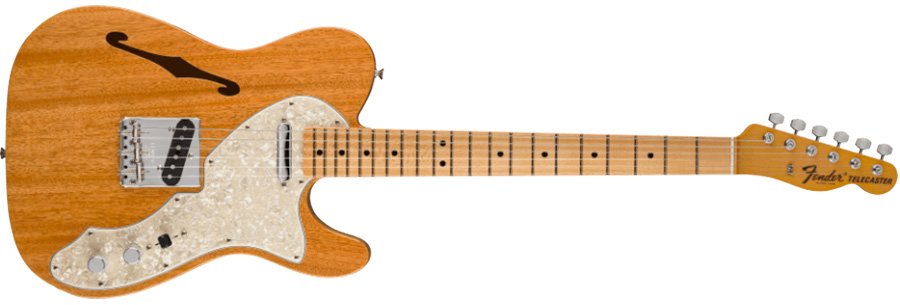
1972 also saw the unveiling of two new Telecasters, the Custom and the Deluxe.
The Custom added a Wide Range humbucker in the neck position with some new controls. Many players had taken to adding a humbucking pickup in place of the bridge pickup in a standard Telecaster (Keith’s “Micawber” being the most recognizable) for a little extra sizzle. Fender noticed this trend, and the Custom came into being. Sporting a humbucker in the neck position and the standard single coil bridge pickup, the Custom became a monster player in the rock scene. The new Les Paul (cough, cough, ahem) controls with two volumes and two tone knobs were familiar to the guitar player of that era. They say, “imitation is the sincerest form of flattery,” right?

The Deluxe went full humbucker mode with a pair of Wide Range humbucking pickups in the neck and bridge positions. It also sported the Les Paul type controls but added a little extra Fender flair. An enlarged headstock shape now sprouted from the neck, and a belly cut was added to the back of the body for more comfort. Most Deluxe Telecasters featured a hardtail bridge, but could be ordered with the same vibrato bridge used on the Stratocaster.

I have to admit, among these Telecasters, a 1972-76 Custom is my favorite. For a few grand you can get your hands on this piece of Fender history. If that is too rich for your blood, Fender has also re-issued this model (MIM), so for less than a grand you can get your funk on!
A Whole New Fender, or was it?
After CBS sold the company to Fender Musical Instruments in 1985 a total revamp of Fender took place. New operating facilities opened in Corona, California, and new management charted a course for the future of the Telecaster. Fender tried to reclaim the glory years of the Telecaster by releasing a reissue model, the first in 1982 while still under the reigns of CBS.
The first ’52 Vintage Series Telecasters were manufactured from 1982-1997 (CBS and FMI). However, this model did not hold true to the specifications of the original Telecaster. I feel this was Fender’s attempt to reproduce an iconic model using their current manufacturing processes and parts. Thinner C shaped necks, reshaped headstocks and bodies, as well as polyurethane finishes with hotter pickups led to these guitars falling short of the original’s glory.
Revised again
Then, in 1998, something changed. Fender introduced the new ’52 American Vintage Reissue (some call them the AVRI models), which boasted many of the qualities found in the original Telecasters. Thicker U-shaped necks, vintage accurate pickups, and even the smallest of details, such as the switch tip redesign better reflected the original vision of Leo ‘s creation. The finish on these models did incorporate the nitrocellulose lacquer of Leo’s day, but was applied over a polyurethane finish for better durability. These guitars were manufactured from 1998 through August of 2012.
And revised again
In late 2012, the Pure Vintage (later called the American Vintage) 52 Telecaster was introduced to the guitar world. This guitar was re-designed using original vintage Telecasters as the models. Body dimensions, neck thicknesses and every aspect of the shape of the Pure Vintage or AV Telecasters were made to match exactly to the original models. Vintage style frets and a 7.25” fretboard radius, bone nuts, period correct pickups, and wiring components made these guitars as close to the originals as possible. Even the aforementioned switch tip was redesigned once again to better match the original. The AV models were also the first to return back to an entire Nitrocellulose finish formulation as found on the original Telecasters. The thin-coat Nitro finishes on the AV series are the closest that Fender has gotten to the finishes on the vintage guitars. The AV series Telecasters were produced between 2012 and 2017, and still have strong followings among guitar aficionados today. Among the latest Telecaster offerings, I think the 2012-2017 AV ’52 Telecasters are some of the best available.
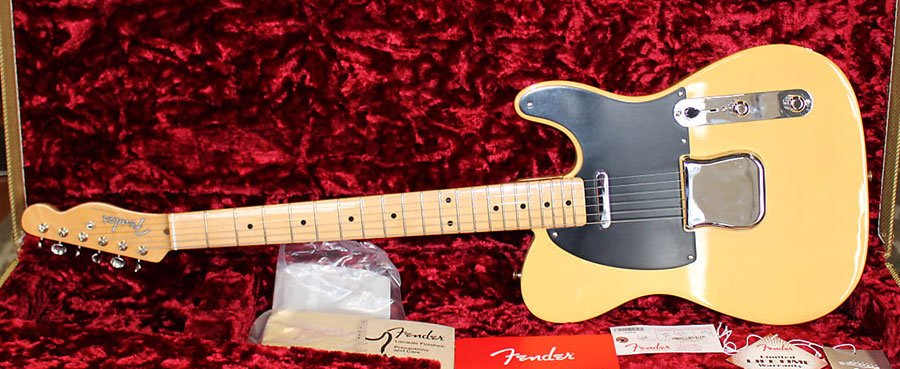
And revised once again
In 2018, Fender introduced the American Original (AO) series, and an AO 50 Telecaster was part of that series. Although similar to the AV series, there were some tweaks made to make the guitar more playable. The polyurethane that protected the previous AVRI models was brought back to increase durability, although a Nitro top coat was added to give the guitar player that lacquer feel. Similar to its predecessor, the AO boasted a few modern upgrades that Tele players would surely appreciate. The new 9.5” radiused neck (updated from the 7.25” neck on the AV) will be appreciated by the modern guitarist who might like the flatter fretboard. The pickups have also been reconfigured to be more period-correct with Alnico 5 magnets, cloth-covered wiring, and a vintage schematic.
So many choices, so little time and money
So, what Telecaster is best for you? Although we have only discussed the Fender Telecaster in this article, there are many options out there including some economical models that punch well above their weight that you can consider.
You really should spend some time playing all the different options that Fender offers. You might not like a 7.25” radiused fretboard chunky baseball neck, but then again, you might love it. You might be a modern player who prefers larger frets and a flatter fretboard, and if that’s the case, you might want to steer clear of those guitars with vintage frets and small radiuses.
As a guitar player, feel is a huge part of the artistry that we bring to music, and you need to feel at one with your instrument. And, the only way to discover what guitar feels best to you is to play as many as you can before you make your decision.
Share your thoughts in our forum! 💬
👉 What’s Your Favorite Telecaster (That You Own or Have Owned)?
Share this post with your friends using these one-click sharing options:
👉 Click here to share on Facebook.
👉 Click here to share on X.
👉 Click here to share on LinkedIn.
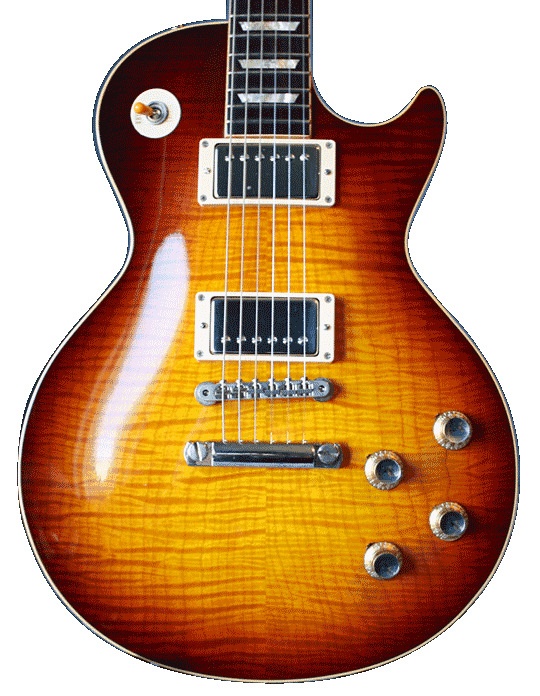
Get the latest reviews, guides and videos in your inbox.